Konqueror
 |
|

Konqueror browser 4.11.5 on openSUSE 13.1
|
|
| Developer(s) | KDE |
|---|---|
| Initial release | 14 October 1996 |
| Stable release | 4.14.3 (November 11, 2014) |
| Written in | C++ (Qt) |
| Operating system | Unix like, Microsoft Windows |
| Engines | WebKit, KHTML |
| Available in | Multilingual |
| Type | Web browser, file browser |
| License | GPLv2+ |
| Website | konqueror |
Konqueror is a free and open-source web browser and file manager that provides file viewer functionality for file systems such as local files, files on a remote FTP server and files in a disk image. It is a core part of the KDE Software Compilation. Konqueror is developed by volunteers and can run on most Unix-like operating systems and on Windows systems. Konqueror is licensed and distributed under the GNU General Public License version 2.
The name "Konqueror" is a reference to the two primary competitors at the time of the browser's first release: "first comes the Navigator, then Explorer, and then the Konqueror". It also follows the KDE naming convention: the names of most KDE programs begin with the letter K.
Konqueror was released with version 2 of KDE on October 23, 2000. It replaces its predecessor, KFM (KDE file manager). With the release of KDE 4, Konqueror was replaced as the default file manager by Dolphin, but is still maintained as the default KDE web browser.
Konqueror can utilize all KIOslaves installed on the user's system. Some examples include:
A complete list is available in the KDE Info Center's Protocols section.
Konqueror supports tabbed document interface and Split views, wherein a window can contain multiple documents in tabs. Multiple document interfaces are not supported, however it is possible to recursively divide a window to view multiple documents simultaneously, or simply open another window.
Konqueror's user interface is somewhat reminiscent of Microsoft's Internet Explorer, though it is more customizable. It works extensively with "panels", which can be rearranged or added. For example, one could have an Internet bookmarks panel on the left side of the browser window, and by clicking a bookmark, the respective web page would be viewed in the larger panel to the right. Alternatively, one could display a hierarchical list of folders in one panel and the content of the selected folder in another. Panels are quite flexible and can even include, among other KParts (components), a console window, a text editor, a media player. Panel configurations can be saved, and there are some default configurations. (For example, "Midnight Commander" displays a screen split into two panels, where each one contains a folder, Web site, or file view.)
...
Wikipedia
